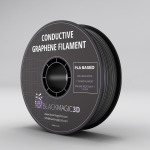World’s First Commercial Conductive Graphene Filaments for 3D Printing
Graphene is the thinnest and strongest material known to man. It is also an excellent electrical and heat conductor that has unique optical properties. Graphene is a 2D material made of carbon atoms, arranged in a honeycomb lattice. Its myriad qualities make graphene worthy of the title “wonder material”, with endless potential for all sorts of applications from membranes to electronics.
Graphene-enhanced nanocomposite materials greatly improve traditional materials used in 3D printing, like plastics. Graphene nanoplatelets can be added to polymers to create materials that are mechanically stronger and boast improved thermal and electrical conductivity.
Graphene 3D Lab is one of the leaders in this new market. The company’s founder and COO, Dr. Elena Polyakova commented in an interview for Graphene-info on the advantages of graphene-based materials over current 3D printing materials: “Fused Filament Fabrication (FFF) — a method of 3D printing in which filament is extruded layer by layer to create objects — capabilities are currently bound by the offerings of filaments, which generally includes non-functional thermoplastics. While such plastics are great for printing desktop models and fascinating gadgets, the real-world applications of printing with such filaments by themselves are limited. By creating a line of materials with functional properties, the capabilities of FFF 3D printers will be greatly expanded. By way of example, filaments infused with graphene can be conductive and much more durable than non-specialized filaments, features which are necessary for a host of applications. We also intend to develop filaments with other functional properties, including magnetic capabilities.”
Graphene 3D Lab also plans to produce 3D printable batteries, based on graphene. These batteries can potentially outperform current commercial batteries, and will come in shapes and sizes that can be tailored to match the designs of specific devices. The company already unveiled a prototype battery.
Many other companies are also working to utilize graphene’s abundance of unusual properties into 3D printing techniques. Graphene Technologies, California-based developer of advanced composites and coatings, developed a unique eco-friendly way to synthesize graphene from carbon dioxide. Graphene Technologies announced a partnership with Stratasys to co-develop graphene-enhanced 3D printing materials
Korea’s KERI Institute developed a technology that enables the use of graphene for 3D printing, which is meant to significantly improve the manufacture of flexible and wearable devices. Their technology enables the 3D printing of objects using metal, plastic and graphene, and can be applied to diverse industrial segments with printed electronics particularly in mind. This new 3D nano printer is capable of controlling its injection nozzle with supreme precision, monitoring the printing process in high definition video to manufacture nanometer level objects. The graphene printed objects are said to be conductive, as well as chemically and structurally stable and durable. KERI has moved to patent this technology and proceed with follow-up research to commercialize it.
Researchers at the Centre for Advanced Structural Ceramics at Imperial College London (ICL) used graphene together with small amounts of a responsive polymer (a polymer that changes upon activation of a ‘chemical switch’), to formulate water based ink or pastes for 3D printing applications. The produced inks allow printing through nozzles as thin as 100 µm and their rheology could also be tailored for processing technologies such as extrusion, gel, or tape casting. Once a structure is made, it is thermally treated in a special atmosphere to recover the properties of graphene. Among the potential applications for this process are flexible electronics and oil adsorption
Photo’s captation: Graphene Filaments for 3D printing












